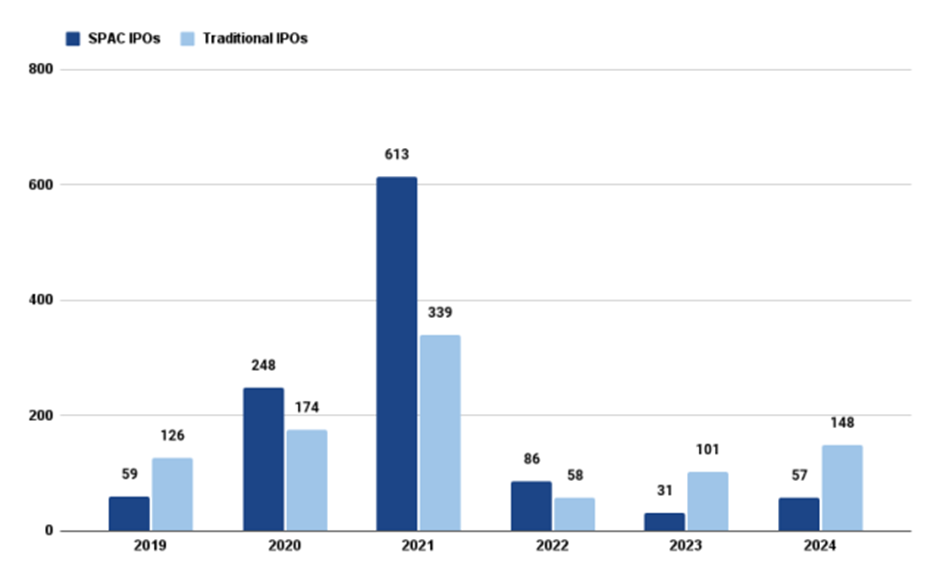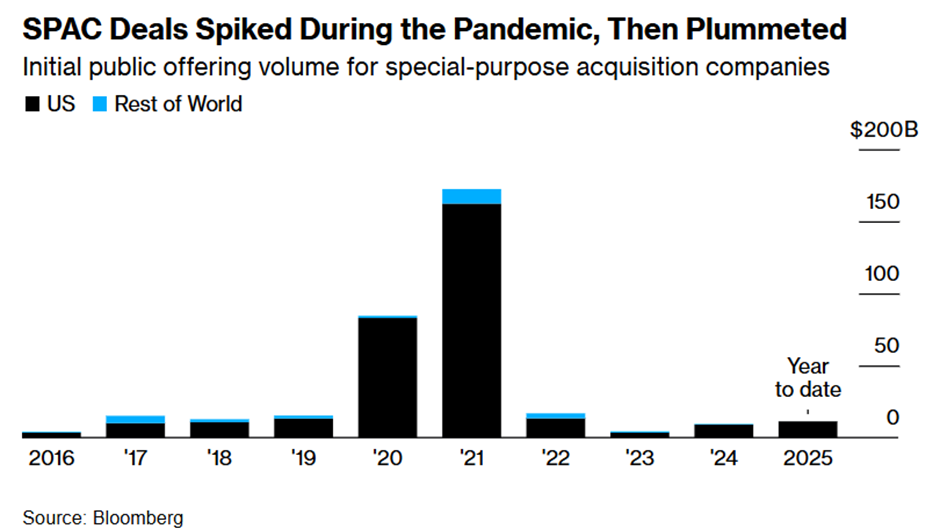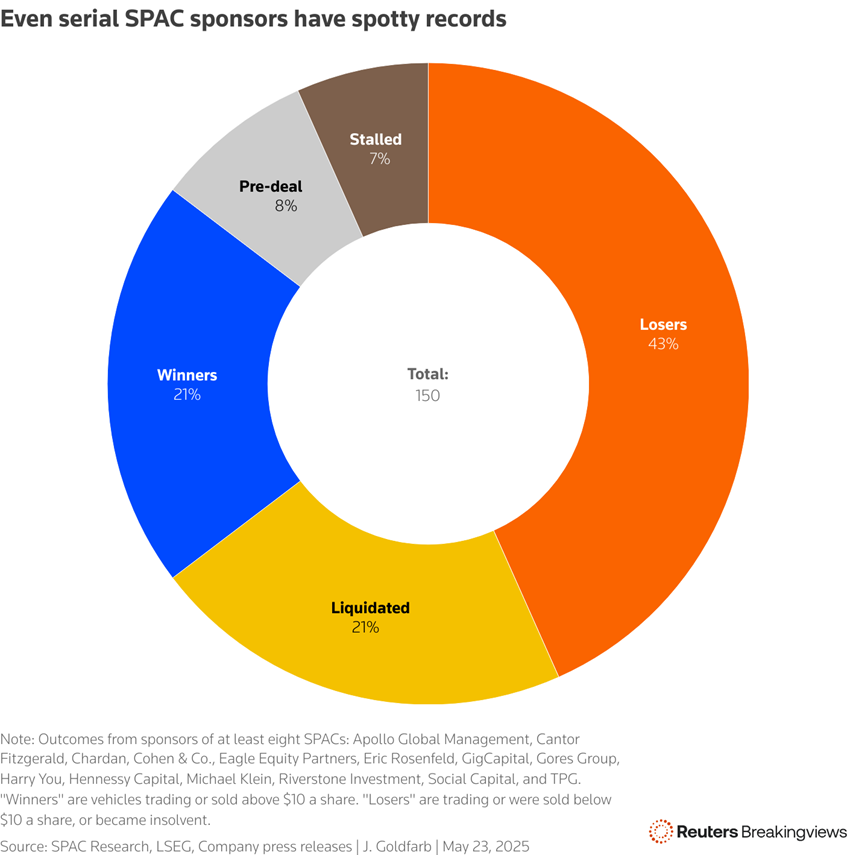Wall Street is buzzing again. With the S&P 500 at record highs and capital flowing into futuristic sectors like AI and crypto, companies are racing to go public. While many opt for the traditional IPO route, others are taking a faster track through Special Purpose Acquisition Companies, or SPACs. After a volatile boom-and-bust cycle in the early 2020s, Special Purpose Acquisition Companies are once again back and drawing attention.
If you are wondering whether it’s the right time to explore SPACs, this article breaks down how the market is behaving, how SPACs work, why they carry unique risks, and what investors should look out for before diving in.
What are SPACs?
A SPAC (Special Purpose Acquisition Company) is a publicly listed shell company that has no commercial operations at the time of its IPO. The goal is to utilize this capital to acquire or merge with a private company, thereby effectively taking it public without the traditional IPO process. Sponsors, including private equity firms, hedge funds, or investment banks, typically form SPACs.
Funds raised are held in a trust and must be used within 18-24 months to complete a deal. If no merger happens, investors are refunded, and the sponsor loses their investment. SPACs offer a faster, less regulated path to public markets.
How SPAC Structure Tilts the Odds in Favor of Sponsors
A core flaw in SPACs lies in the reward-to-risk imbalance. For a nominal $25,000 investment, the sponsor typically receives 20% of the post-IPO equity, a stake worth millions if a merger is successful. Even if the acquired company underperforms, the sponsor can walk away with substantial profits, while public investors absorb the downside.
Factoring in fees, sponsor shares, and other compensation, SPACs can end up costing more than traditional IPOs. Public investors fund the majority of the capital but end up diluted, as sponsor shares are added without proportional investment. By the time a merger closes, roughly one-third of the capital raised may already be gone due to fees and redemptions.
Moreover, many private equity firms use SPACs to exit aging assets, shifting risk to retail investors. PwC data shows PE firms are sitting on nearly $1 trillion in unsold assets, raising potential concerns about deal quality. This misalignment of incentives suggests that SPACs may prioritize completing deals over securing strong ones, putting ordinary retail investors at a clear disadvantage.
Commercial Aspect | Paid By | Received By | Details |
Underwriting Fee | Public Investors | Investment Bank | 5.5% of IPO funds for advisory services |
Initial Capital | Sponsor | SPAC | Covers IPO and admin costs (2–5% of IPO size) |
Founder Shares | Sponsor | Sponsor | ~20% equity for ~$25,000; reward for forming the SPAC |
Public Warrants | Public Investors | Public Investors | Rights to buy more shares post-merger |
Private Warrants | Sponsor | Sponsor | Similar to public warrants but longer-term |
PIPE Investment | Institutional Investors | SPAC / Target Co. | Additional capital, usually at $10/share |
Redemption Option | SPAC Trust (public funds) | Public Investors | Refund of capital + interest if investor wants to opt out before vote on merger |
Quick Glossary for Retail Investors:
- PIPE Investment: Private funding from big investors that helps complete the SPAC merger.
- Public Warrants: Bonus for public investors to buy more shares at a fixed price after the merger.
- Private Warrants: Issued to sponsors, often more flexible than public ones.
- Non-redeemable: Cannot be exchanged for cash before the merger.
- Redemption Option: Allows investors to take their money back with interest if they don’t want to join the merger.
The SPAC Market: Past Trends and Performance
The pandemic years of 2020 and 2021 marked the golden age of SPACs, fuelled by high liquidity, low interest rates, and strong retail investor participation. These blank-check firms offered a faster, less regulated route to public markets compared to traditional IPOs. In just two years, SPACs raised a staggering $250 billion across 860 deals, accounting for nearly 62% of all U.S. market debuts, according to SPACInsider.

But the gold rush didn’t last. A sharp correction followed in 2022 and 2023. Roughly 50% of these SPACs failed to identify a merger target within the typical 2-year window and were forced to return cash to shareholders. In hindsight, these investors may have been the lucky ones. By early May, more than 90% of SPACs that completed a merger and remain publicly listed now trade below their original $10 offer price. Notable collapses like WeWork and Lordstown Motors wiped out billions in value. By 2024, the hype cooled, and fewer, more cautious deals became the norm.
Are SPACs back in 2025?
In 2025, SPAC activity is picking up. As of June 26, 61 blank check companies have gone public, raising $12.4 billion, which already surpasses the total raised in 2024. Even Goldman Sachs, which exited the space in 2022, is back in the game. Activity remains well below the 2021 peak, when Goldman ranked as the second-largest underwriter, but momentum is building again.

According to SPAC Analytics, SPACs have accounted for almost two-thirds of US IPO volume so far this year and more than 40% of proceeds. This revival is being driven by a combination of improved investor risk appetite and a more constructive regulatory environment. Around 10% of pre-deal SPACs and 25% of those with announced transactions are now trading above their cash value, indicating that investors are once again chasing higher returns. Regulatory changes have also helped. The SEC's 2024 overhaul enhanced investor protections but avoided heavy restrictions, particularly around underwriter liability.
At the same time, SPAC sponsors are increasingly targeting speculative sectors such as crypto, blockchain, quantum computing, autonomous trucking, and nuclear technology. These areas are seen as potential catalysts that can generate investor excitement. That excitement is crucial because many hedge funds that initially fund SPACs often demand their money back with interest if the deal does not convince them, a process known as redemption. In 2025, approximately 95% of SPAC funds have been redeemed in closed deals, according to SPAC Research data.
Despite the renewed activity, performance remains low. Of the roughly 20 companies that have gone public via SPACs this year, the median performance shows a decline of about 75% from the standard $10 IPO price. This underperformance reflects lingering investor scepticism and suggests the current SPAC cycle may not yet deliver significantly better outcomes than the previous one. Until that track record improves, the SPAC revival is likely to remain fragile. While SPACs offer a quicker route to the public markets, history shows that returns have favored sponsors and insiders more than long-term shareholders.
What Should Investors Look Out for Before Investing in a SPAC?
Investing in a Special Purpose Acquisition Company (SPAC) can be rewarding, but it also poses various risks. Before jumping in, here are the key factors investors should evaluate:
Sponsor Reputation and Track Record
The most critical factor in a SPAC is the quality of its sponsor. A good sponsor increases the chances of success for a deal, but even seasoned names have seen deals underperform. In 2025, more than 40% of SPACs led by well-known sponsors traded below $10, and nearly 20% had to liquidate.

Institutional Involvement
The presence of respected institutional investors can act as a positive signal. While it does not assure success, it reflects a level of due diligence and external validation that retail investors can use as a reference.
Quality of the Merger Target
Many SPACs fail because they target companies with a presence in futuristic sectors that are pre-revenue or loss-making. Investors should prefer SPACs that aim to merge with healthy, established businesses rather than early-stage ventures with limited revenue. A SPAC is not a substitute for venture capital and should not be used to bring immature startups to public markets prematurely.
Industry and Business Fundamentals
Understand the target company’s market, scalability, and competitive edge. Be cautious of firms with vague models or heavy reliance on hype.
Case in Point
The Gores Group provides an example of how SPACs can work when executed with discipline. In 2016, it acquired Hostess Brands for $725 million. Seven years later, JM Smucker bought the firm for $5.6 billion. Another Gores deal, Verra Mobility, has more than doubled since its 2018 SPAC listing. These cases show that with the right sponsor and target, long-term value can be created.
Final Thoughts on Navigating the SPAC Market in 2025
The revival of SPACs and IPOs in 2025 marks a significant turning point for U.S. equity markets. While the speculative frenzy of 2021 is unlikely to return, today’s deals are being shaped by more mature companies, increased regulatory oversight, and targeted investor interest in themes such as AI, cryptocurrency, and digital finance.
Retail investors looking to participate must go beyond the excitement and understand the economics, incentives, and risks behind each offering. In a more mature environment, SPACs still hold potential if you know where to look.